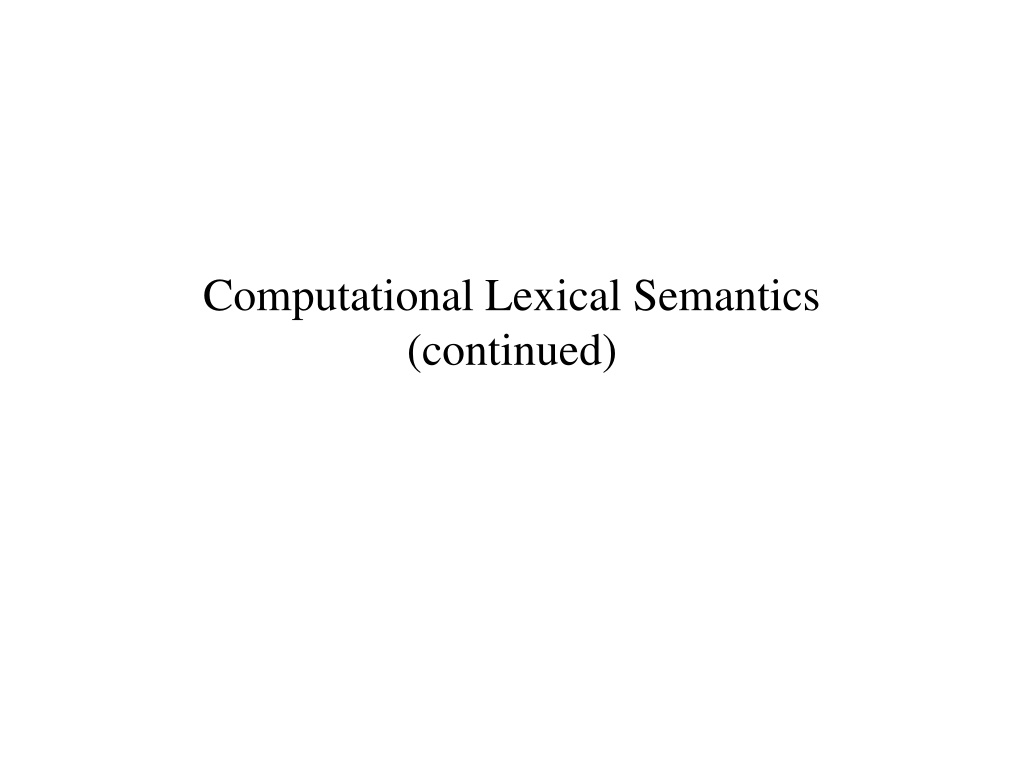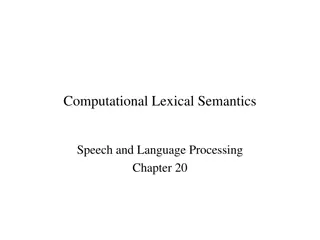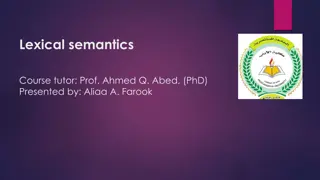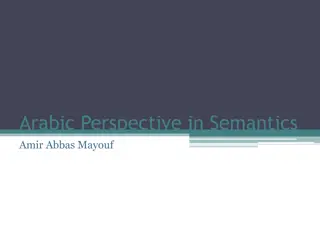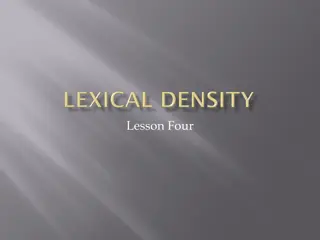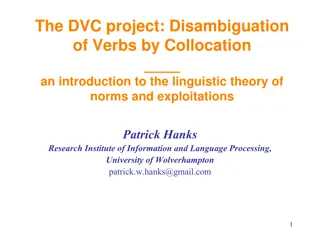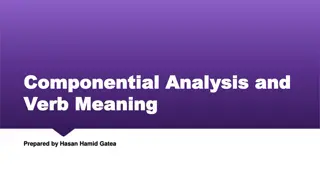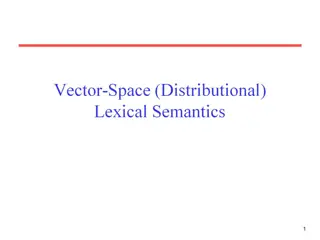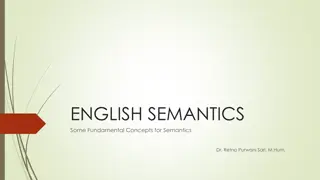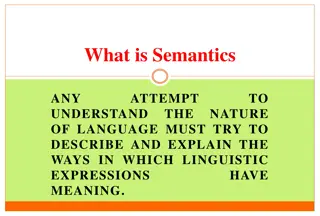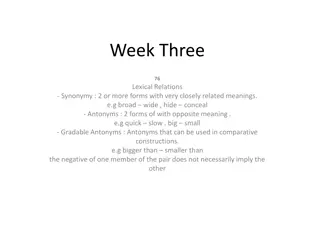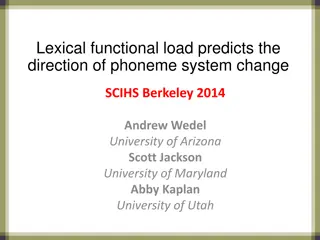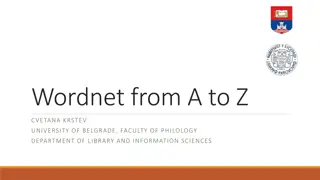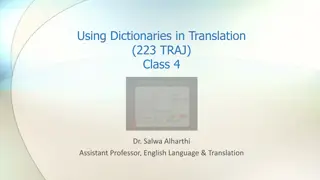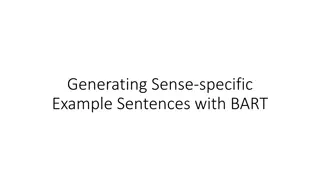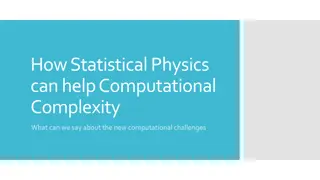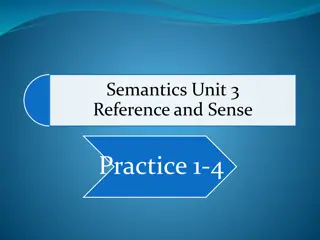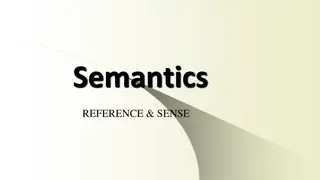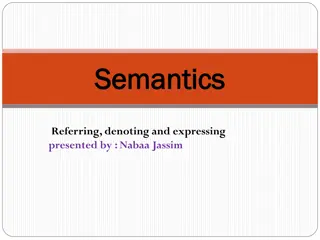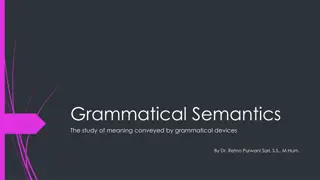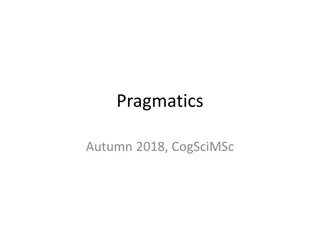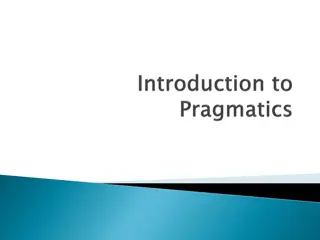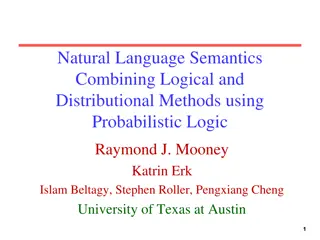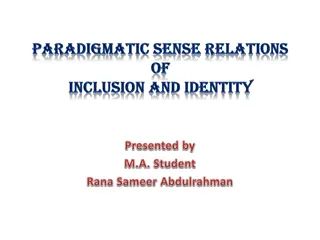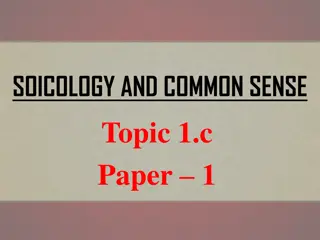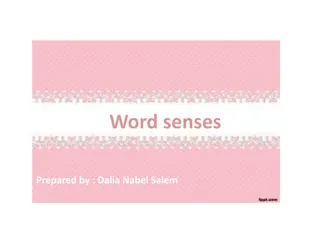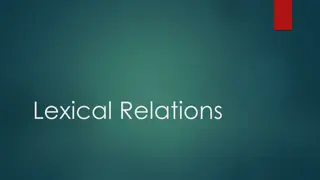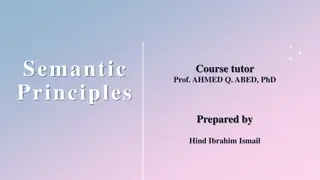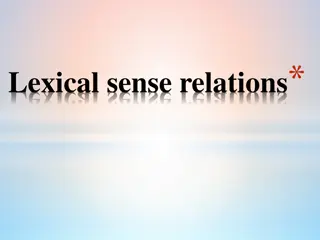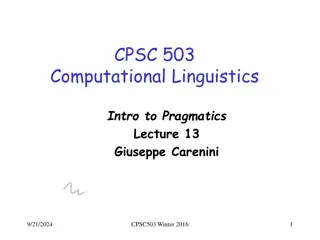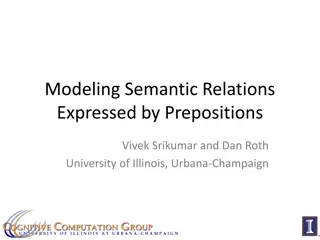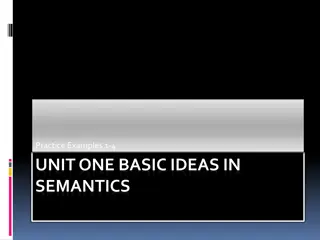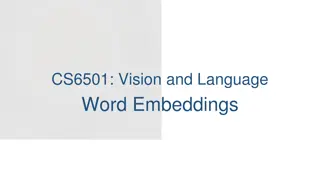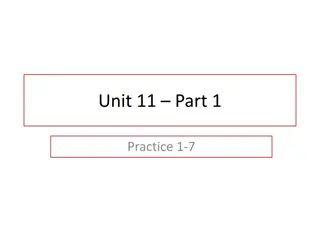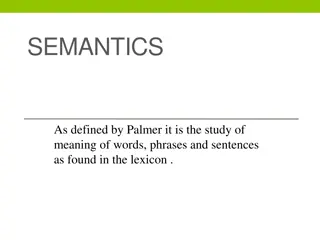Understanding Word Sense Disambiguation in Computational Lexical Semantics
Word Sense Disambiguation (WSD) is a crucial task in Computational Lexical Semantics, aiming to determine the correct sense of a word in context from a fixed inventory of potential word senses. This process involves various techniques such as supervised machine learning, unsupervised methods, thesaurus-based approaches, and more. WSD is essential for tasks like English-to-Spanish machine translation and speech synthesis dealing with homographs. Different senses of a word, such as "bat" with multiple meanings, showcase the concepts of homonymy and polysemy. Supervised WSD involves training classifiers on tagged corpora to assign senses to words in new contexts effectively.
Download Presentation

Please find below an Image/Link to download the presentation.
The content on the website is provided AS IS for your information and personal use only. It may not be sold, licensed, or shared on other websites without obtaining consent from the author. Download presentation by click this link. If you encounter any issues during the download, it is possible that the publisher has removed the file from their server.
E N D
Presentation Transcript
Computational Lexical Semantics (continued)
Word Sense Disambiguation (WSD) Given A word in context, A fixed inventory of potential word senses Decide which sense of the word this is What set of senses? English-to-Spanish MT: set of Spanish translations Speech Synthesis: homographs like bass and bow In general: the senses in a thesaurus like WordNet
TheWordNet entry for the noun bathas the following distinct senses. Cluster these senses by using the definitions of homonymy and polysemy. bat#1: nocturnal mouselike mammal bat#2: (baseball) a turn trying to get a hit bat#3: a small racket. . . for playing squash bat#4: the club used in playing cricket bat#5: a club used for hitting a ball in various games
Two Variants of WSD Lexical Sample task Small pre-selected set of target words And inventory of senses for each word Typically supervised ML: classifier per word All-words task Every word in an entire text A lexicon with senses for each word Data sparseness: can t train word-specific classifiers ~Like part-of-speech tagging Except each lemma has its own tagset Less human agreement so upper bound is lower
Approaches Supervised machine learning Unsupervised Thesaurus/Dictionary-based techniques Selectional Association Lightly supervised Bootstrapping Preferred Selectional Association
Supervised Machine Learning Approaches Supervised machine learning approach Training corpus depends on task Train a classifier that can tag words in new text Just as we saw for part-of-speech tagging What do we need? Tag set ( sense inventory ) Training corpus (words tagged in context with sense) Set of features extracted from the training corpus A classifier
Supervised WSD: WSD Tags What s a tag? A dictionary sense? For example, for WordNet an instance of bass in a text has 8 possible tags or labels (bass1 through bass8).
Bass in WordNet The noun bass has 8 senses in WordNet bass - (the lowest part of the musical range) bass, bass part - (the lowest part in polyphonic music) bass, basso - (an adult male singer with the lowest voice) sea bass, bass - (flesh of lean-fleshed saltwater fish of the family Serranidae) freshwater bass, bass - (any of various North American lean- fleshed freshwater fishes especially of the genus Micropterus) bass, bass voice, basso - (the lowest adult male singing voice) bass - (the member with the lowest range of a family of musical instruments) bass -(nontechnical name for any of numerous edible marine and freshwater spiny-finned fishes)
What kind of Corpora? Lexical sample task: Line-hard-serve corpus - 4000 examples of each Interest corpus - 2369 sense-tagged examples All words: Semantic concordance: a corpus in which each open-class word is labeled with a sense from a specific dictionary/thesaurus. SemCor: 234,000 words from Brown Corpus, manually tagged with WordNet senses SENSEVAL-3 competition corpora - 2081 tagged word tokens
SemCor <wf pos=PRP>He</wf> <wf pos=VB lemma=recognize wnsn=4 lexsn=2:31:00::>recognized</wf> <wf pos=DT>the</wf> <wf pos=NN lemma=gesture wnsn=1 lexsn=1:04:00::>gesture</wf> <punc>.</punc> 12
What Kind of Features? Weaver (1955) If one examines the words in a book, one at a time as through an opaque mask with a hole in it one word wide, then it is obviously impossible to determine, one at a time, the meaning of the words. [ ] But if one lengthens the slit in the opaque mask, until one can see not only the central word in question but also say N words on either side, then if N is large enough one can unambiguously decide the meaning of the central word. [ ] The practical question is : `What minimum value of N will, at least in a tolerable fraction of cases, lead to the correct choice of meaning for the central word?
Frequency-based WSD WordNet first sense heuristic, about 60-70% accuracy To improve, need context Selectional restrictions Topic
dishes washing dishes he simple dishes including convenient dishes to of dishes and bass free bass with pound bass of and bass player his bass while
S: (n) dish (a piece of dishware normally used as a container for holding or serving food) "we gave them a set of dishes for a wedding present S: (n) dish (a particular item of prepared food) "she prepared a special dish for dinner" .
dishes includes washing dishes he says several simple dishes including braised and convenient dishes to fix variety of dishes and regional bass the free bass with ease 52 pound bass of a guitar and bass player stand caught his bass while fishing
In our house, everybody has a career and none of them includes washing dishes, he says. In her tiny kitchen at home, Ms. Chen works efficiently, stir-frying several simple dishes, including braised pig s ears and chcken livers with green peppers. Post quick and convenient dishes to fix when you re in a hurry. Japanese cuisine offers a great variety of dishes and regional specialties
We need more good teachers right now, there are only a half a dozen who can play the free bass with ease. Though still a far cry from the lake s record 52 pound bass of a decade ago, you could fillet these fish again, and that made people very, very happy. Mr. Paulson says. An electric guitar and bass player stand off to one side, not really part of the scene, just as a sort of nod to gringo expectations again. Lowe caught his bass while fishing with pro Bill Lee of Killeen, Texas, who is currently in 144th place with two bass weighing 2-09.
Feature Vectors A simple representation for each observation (each instance of a target word) Vectors of sets of feature/value pairs I.e. files of comma-separated values These vectors should represent the window of words around the target How big should that window be?
What sort of Features? Collocational features and bag-of-words features Collocational Features about words at specific positions near target word Often limited to just word identity and POS Bag-of-words Features about words that occur anywhere in the window (regardless of position) Typically limited to frequency counts
Example Example text (WSJ) An electric guitar and bass player stand off to one side not really part of the scene, just as a sort of nod to gringo expectations perhaps Assume a window of +/- 2 from the target
Collocations Position-specific information about the words in the window guitar and bass player stand [guitar, NN, and, CC, player, NN, stand, VB] Wordn-2, POSn-2, wordn-1, POSn-1, Wordn+1 POSn+1 In other words, a vector consisting of [position n word, position n part-of-speech ]
Bag of Words Information about what words occur within the window First derive a set of terms to place in the vector Then note how often each of those terms occurs in a given window
Co-Occurrence Example Assume we ve settled on a possible vocabulary of 12 words in bass sentences: [fishing, big, sound, player, fly, rod, pound, double, runs, playing, guitar, band] The vector for: guitar and bass player stand
Co-Occurrence Example Assume we ve settled on a possible vocabulary of 12 words in bass sentences: [fishing, big, sound, player, fly, rod, pound, double, runs, playing, guitar, band] The vector for: guitar and bass player stand [0,0,0,1,0,0,0,0,0,0,1,0]
Classifiers Once we cast the WSD problem as a classification problem, many techniques possible Na ve Bayes Decision lists Decision trees Neural nets Support vector machines Nearest neighbor methods
Classifiers Choice of technique, in part, depends on the set of features that have been used Some techniques work better/worse with features with numerical values Some techniques work better/worse with features that have large numbers of possible values For example, the feature the word to the left has a fairly large number of possible values
Classification Methods: Supervised Machine Learning Input: a word w in a text window d (which we ll call a document ) a fixed set of classes C ={c1, c2, , cJ} A training set of m hand-labeled text windows again called documents (d1,c1),....,(dm,cm) Output: a learned classifier :d c 29
Nave Bayes ( | ) ( ) p V s p s arg max S s arg max S s = p(s|V), or Where s is one of the senses S possible for a word w and V the input vector of feature values for w Assume features independent, so probability of V is the product of probabilities of each feature, given s, so p(V) same for any ( ) p V n = = ( | ) ( | ) p V s p s vj 1 j n = = Then s ( ) ( | ) p s p s arg max S vj 1 j s
How do we estimate p(s) and p(vj|s)? p(si) is max. likelihood estimate from a sense- tagged corpus (count(si,wj)/count(wj)) how likely is bank to mean financial institution over all instances of bank? P(vj|s) is max. likelihood of each feature given a candidate sense (count(vj,s)/count(s)) how likely is the previous word to be river when the sense of bank is financial institution Calculate for each possible sense and take the highest scoring sense as the most likely choice n = = s ( ) ( | ) p s p s arg max S vj 1 j s
Nave Bayes Evaluation On a corpus of examples of uses of the word line, na ve Bayes achieved about 73% correct Is this good?
Doc 1 2 3 4 5 Words fish smoked fish fish line fish haul smoked guitar jazz line line guitar jazz jazz Class f f f g ? P(c)=Nc Training N P(w|c)=count(w,c)+1 count(c)+|V | Test V = {fish, smoked, line, haul, guitar, jazz} Priors: P(f)= P(g)= 3 4 1 Choosing a class: P(f|d5) 4 3/4 * 2/14 * (1/14)2 * 1/14 0.00003 Conditional Probabilities: P(line|f) = P(guitar|f) = P(jazz|f) = P(line|g) = P(guitar|g) = P(jazz|g) = (1+1) / (8+6) = 2/14 (0+1) / (8+6) = 1/14 (0+1) / (8+6) = 1/14 P(g|d5) 1/4 * 2/9 * (2/9)2 * 2/9 0.0006 (1+1) / (3+6) = 2/9 (1+1) / (3+6) = 2/9 (1+1) / (3+6) = 2/9 34
Decision Lists Can be treated as a case statement .
Learning Decision Lists Restrict lists to rules that test a single feature Evaluate each possible test and rank them based on how well they work Order the top-N tests as the decision list
Yarowskys Metric On a binary (homonymy) distinction used the following metric to rank the tests Sense ( | ) P Feature log 1 Sense ( | ) P Feature 2 This gives about 95% on this test
WSD Evaluations and Baselines In vivo (intrinsic) versus in vitro (extrinsic) evaluation In vitro evaluation most common now Exact match accuracy % of words tagged identically with manual sense tags Usually evaluate using held-out data from same labeled corpus Problems? Why do we do it anyhow? Baselines: most frequent sense, Lesk algorithm
Most Frequent Sense Wordnet senses are ordered in frequency order So most frequent sense in WordNet = take the first sense Sense frequencies come from SemCor
Ceiling Human inter-annotator agreement Compare annotations of two humans On same data Given same tagging guidelines Human agreements on all-words corpora with WordNet style senses 75%-80%
Unsupervised Methods: Dictionary/Thesaurus Methods The Lesk Algorithm Selectional Restrictions
Simplified Lesk Match dictionary entry of sense that best matches context
Simplified Lesk Match dictionary entry of sense that best matches context: bank1 (deposits, mortgage)
Original Lesk: pine cone Compare entries for each context word for overlap
Original Lesk: pine cone Compare entries for each context word for overlap Cone3 selected: evergreen, tree
Time flies like an arrow what are the correct senses? time#n#5 (the continuum of experience in which events pass from the future through the present to the past) time#v#1 (measure the time or duration of an event or action or the person who performs an action in a certain period of time) he clocked the runners flies#n#1 (two-winged insects characterized by active flight) flies#v#8 (pass away rapidly) Time flies like an arrow ; Time fleeing beneath him like#v#4 (feel about or towards; consider, evaluate, or regard) How did you like the President s speech last night? like#a#1 (resembling or similar; having the same or some of the same characteristics; often used in combination) suits of like design ; a limited circle of likeminds ; members of the cat family have like dispositions ; as like as two peas in a pod ; doglike devotion ; a dreamlike quality
Try the original algorithm on Time flies like an arrow using WordNet senses below. Assume that the words are to be disambiguated one at a time, from left to right, and that the results from earlier decisions are used later in the process. time#n#5 (the continuum of experience in which events pass from the future through the present to the past) time#v#1 (measure the time or duration of an event or action or the person who performs an action in a certain period of time) he clocked the runners flies#n#1 (two-winged insects characterized by active flight) flies#v#8 (pass away rapidly) Time flies like an arrow ; Time fleeing beneath him like#v#4 (feel about or towards; consider, evaluate, or regard) How did you like the President s speech last night? like#a#1 (resembling or similar; having the same or some of the same characteristics; often used in combination) suits of like design ; a limited circle of likeminds ; members of the cat family have like dispositions ; as like as two peas in a pod ; doglike devotion ; a dreamlike quality
Time flies like an arrow time#n#5 (the continuum of experience in which events pass from the future through the present to the past) time#v#1 (measure the time or duration of an event or action or the person who performs an action in a certain period of time) he clocked the runners flies#n#1 (two-winged insects characterized by active flight) flies#v#8 (passaway rapidly) Timeflies like an arrow ; Time fleeing beneath him like#v#4 (feel about or towards; consider, evaluate, or regard) How did you like the President s speech last night? like#a#1 (resembling or similar; having the same or some of the same characteristics; often used in combination) suits of like design ; a limited circle of likeminds ; members of the cat family have like dispositions ; as like as two peas in a pod ; doglike devotion ; a dreamlike quality Time WSD : tie, backoff to most frequent, but can t because POS differ
Time flies like an arrow time#n#5 (the continuum of experience in which events pass from the future through the present to the past) time#v#1 (measure the time or duration of an event or action or the person who performs an action in a certain period of time) he clocked the runners flies#n#1 (two-winged insects characterized by active flight) flies#v#8 (passaway rapidly) Time flies likean arrow ; Time fleeing beneath him like#v#4 (feel about or towards; consider, evaluate, or regard) How did you likethe President s speech last night? like#a#1 (resembling or similar; having the same or some of the same characteristics; often used in combination) suits of like design ; a limited circle of likeminds ; members of the cat family have likedispositions ; as like as two peas in a pod ; doglike devotion ; a dreamlike quality Flies WSD: select verb
Corpus Lesk Add corpus examples to glosses and examples The best performing variant
